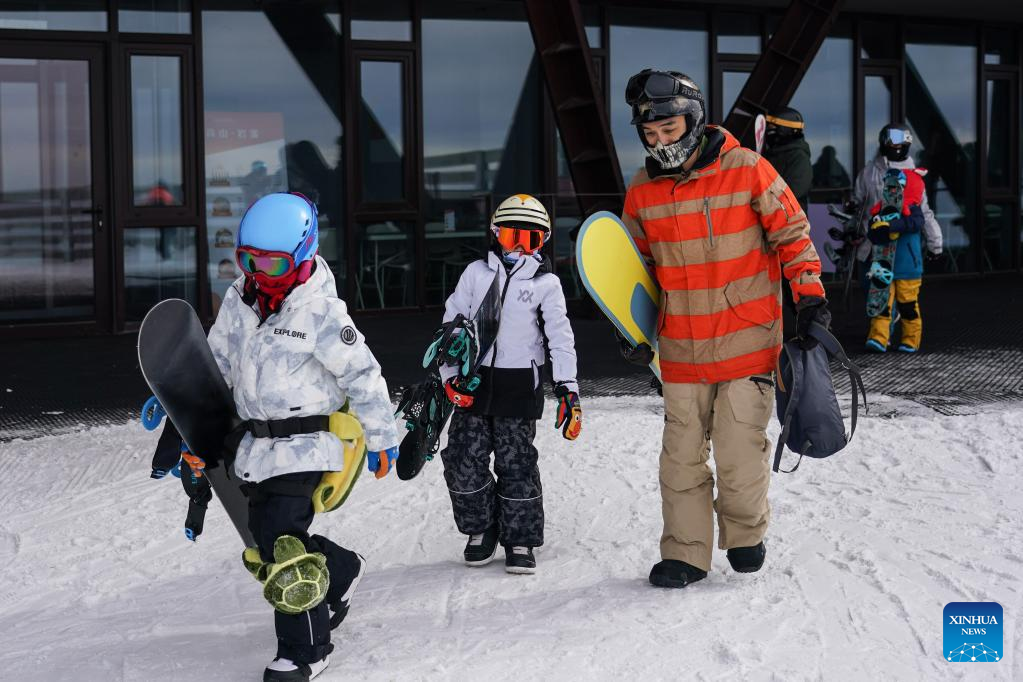Winter tourism benefits from Olympic legacy
 0 Comment(s)
0 Comment(s) Print
Print E-mail China Daily, February 4, 2023
E-mail China Daily, February 4, 2023

People prepare to ski at National Alpine Skiing Centre in Yanqing District, Beijing, capital of China, Feb. 2, 2023. Driven by the 2022 Beijing Winter Olympics, ice and snow tourism has gradually gained popularity among Chinese people. Various competition venues, as the legacy of the Beijing Winter Olympics, offered easy access to ice-and-snow facilities for the general public. (Xinhua/Peng Ziyang)
As China celebrates the first anniversary of the successful hosting of the Beijing 2022 Winter Olympics on Saturday, the nation is also ushering in the high-quality development of winter tourism, which is expected to boost the nation's winter economy in the post-Olympic era.
From Saturday, Beijing and Zhangjiakou, the co-host city in Hebei province, will host a number of events to share the good memories of the Beijing Winter Olympics, promote the Olympic spirit and Olympic culture and further foster the enthusiasm of the public to participate in ice and snow sports by tapping into the rich heritage of the Winter Olympics.
The China Tourism Academy recently forecast that the over 300 million visits will be made to snow and ice-related destinations or resorts in China during the winter season from late 2022 to early 2023.
The number will reach about 520 million in the 2024-25 winter season and winter tourism revenue will rise to 720 billion yuan ($107 billion) by that time, according to the academy.
The nation's winter tourism witnessed impressive growth in the winter of 2021-22, thanks to the success of the Beijing 2022 Winter Olympics. According to the academy, the number of visits to snow and ice-related destinations or resorts increased twofold to 344 million during that winter season, from the winter of 2016-17.
Winter tourism revenue increased to 474 billion yuan in the 2021-22 season from 270 billion yuan in 2016-17.
The recently ended Spring Festival holiday, from Jan 21 to 27, has also shown positive signals about the boom in winter tourism.
For example, Heilongjiang province, one of the nation's most popular destinations for winter sports and snow scenery, received about 11 million visits during the seven-day holiday, roughly 92 percent of the number in 2019.
Harbin Ice-Snow World, the province's most popular attraction for its breathtaking ice sculptures and entertainment events, saw over 20,000 visits in a single day on Jan 24 — the fourth day of Spring Festival holiday, up a staggering 803.2 percent year-on-year, according to the province's department of culture and tourism.
Neighboring Jilin province, another popular destination for snow lovers, also witnessed a Spring Festival travel boom.
According to the Ministry of Culture and Tourism, around 11.55 million visits were made to the province during the holiday, a year-on-year rise of 23.61 percent. This generated tourism-related revenue of about 11.2 billion yuan for Jilin, up 33.31 percent year-on-year.
"I will never forget the experience in Harbin, which was amazing," said Wang Shilan, a 32-year-old from Guangdong province.
"Guangzhou, the city where I live, doesn't have a distinct four seasons, let alone snow, so Harbin was a good choice, with its beautiful snowy views and the exotic architecture in the downtown area."
He said that he spent two days in Harbin and then went to Changbai Mountain in Jilin.
"I went skiing in Jilin. The ski track there was quite good, and it was an unforgettable trip."
The growing popularity of snow and ice destinations has also driven the growth of supporting facilities and accommodation in fields such as winter sports gears and hotels.
Homestay operator Tujia took the just completed Spring Festival holiday as an example, saying that bookings for homestays near ski resorts surged three times during the Spring Festival holiday from the same period in 2019.
Jilin, a traditionally popular winter tourism destination, saw an even better performance with homestay bookings near ski resorts increasing 16 times over the holiday compared with the same period in 2019.
According to the China Tourism Academy, the nation's winter tourism sector remains stronger in the three northeastern provinces, the Beijing-Tianjin-Hebei region and the Xinjiang Uygur autonomous region because of their colder climate and longer history of winter sports.
But the nation's southern provinces have shown growing momentum in terms of winter tourism development in past few years thanks to construction of indoor ski resorts and people's stronger desire for ice and snow-related entertainment, said the academy.
Dai Bin, the academy's president, said that with continuous efforts and supportive policies from all levels of governments driving the development of winter tourism, this has also invigorated local economies.
To ensure the sustainable development of the winter tourism industry, he said it's important to develop a batch of "creative manufacturers" in fields such as sports gear, as well as among operators of snow and ice resorts and theme parks.






Go to Forum >>0 Comment(s)